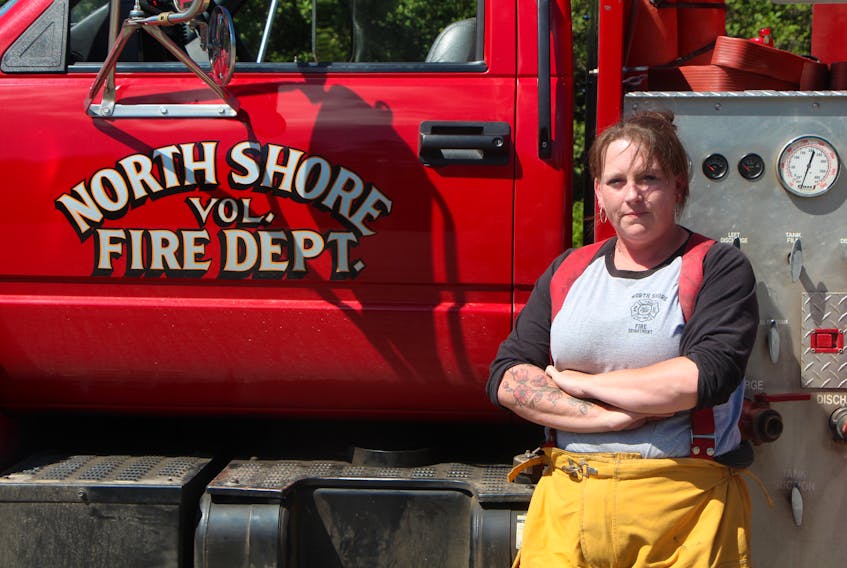Cellphone coverage is a touchy subject in the Cape George area. Kristen MacEachern, deputy fire chief with the North Shore Volunteer Fire Department, expressed her frustration at the quality of cell coverage – or rather, lack thereof – in the area.
“It’s non-existent, from just past North Grant to Malignant Cove,” she said, describing the lack of adequate coverage in the area the North Shore Volunteer Fire Department is responsible for. “You have at least two spots where you have nothing. It’s ridiculous. There’s just nothing there.”
Over coffee at the North Shore Fire Department, MacEachern admitted she gets “very nervous,” when the department gets emergency calls – specifically because there’s always anxiety, in the back of her mind, that the person calling in the emergency may have faced delays in getting through to them, due to unreliable cell service.
MacEachern stressed that lack of coverage in the Cape George area isn’t just inconvenient – it’s outright dangerous.
MacEachern directly attributes one fatality, when a Maryvale woman died of exposure, after her four-wheeler overturned, and she was unable to get help in time, to a lack of cellphone service that prevented help from getting there in time.
That was hardly the only time such an incident occurred.
“Another time, a woman had her car overturned, and she was stuck in the vehicle, upside-down, for 20 minutes, before someone came along,” MacEachern said.
Eventually, the good Samaritan who discovered the lady trapped in her vehicle had to drive several minutes down the road themselves, before they could get the cell service needed to call the authorities.
“That could have gone really badly. We’re on the road now with calls, and we’re not able to get a hold of each other,” she said. “People don’t have home phones anymore, and for the most part, we all have cellphones. It’s almost impossible to get in touch with each other. Even our radios are spotty.”
The members of the North Shore Volunteer Fire Department use an application on their phones called IamResponding – a service that allows them to pick up calls and confirm that they are on their way to help. MaEachern said its usefulness is drastically reduced, and “most of the time it only works right at the fire hall, where we have wireless Internet,” a service that often doesn’t satisfactorily work to begin with, because of poor service in the area.
In addition to a lack of coverage, MacEachern has observed that even in areas – like ones near Livingston’s Cove – there is unreliable service. And even where there is service, it can “bounce.”
“You’ll get bouncing [signals],” MacEachern said. “The signal bounces off two separate towers, so you’re bouncing off Nova Scotia and P.E.I at the same time. We’ve had emergency calls that bounce off P.E.I., and they’ve been sent to the north shore from P.E.I.,” she said.
Adding to the confusion and danger is the fact that P.E.I. also has a fire department called the North Shore Volunteer Fire Department – so if a call bounces in error to P.E.I, there is a great deal of potential for further delays in a situation “where, already, 1,000 things can go wrong,” MacEachern said.
Speaking up
MacEachern and her fellow firefighters have not taken this issue lying down. They have consulted the Municipality of the County of Antigonish – something that hasn’t yet resulted in a tangible change.
“The municipality is completely on board. We talked about the cost of funding towers, and how important those towers are – and it just ended there, without going anywhere,” MacEachern said.
MacEachern expressed similar disappointed with telecommunication companies which are responsible for technological infrastructure in the area, and what little she sees them having done to rectify the problem.
“Providers are saying the technology is constantly being upgraded, and they’re putting a tower here and there. They promise people better service – and it never seems to happen,” she said. “People are paying the same amount as everyone else for bills and cell coverage, and they’re not getting it. You don’t pay a lower rate for substandard service.”
Technical details
According to the Municipality of the County of Antigonish, cellular towers in the county are owned and run by three companies: Bell, Rogers and Eastlink.
Telus, and a number of other providers use Bell’s infrastructure to provide service in Antigonish County.

Contributed photo)
In an email response, Isabelle Boulet with Bell noted wireless strength in rural areas can often be limited.
“Advanced communications networks are expensive to build and operate, and the business case for expanded wireless coverage in areas of low population density is especially challenging with private investment alone,” Boulet wrote.
Boulet wrote that while Bell is “always looking for network expansion opportunities, including partnerships with governments and communities,” it has no plans for any enhancements of projects in the Cape George area anytime soon.
When Rogers was contacted on the matter, Heather Robinson, the company's director for regional public affairs wrote, "we are always exploring opportunities to expand our network and always welcome conversations with local communities about improved coverage."
In an email to The Casket, a representative from Eastlink wrote that the company has no immediate plans to upgrade service to the Cape George area, but "continue(s) to work and collaborate with communities and municipalities in the devleopment of partnership opportunities to upgrade more rural areas across the province."
"although we have no immediate plans for this particular area, we continue to work and collaborate with communities and municipalities in the development of parntership opportunities to upgrade more rural areas across the province."
RELATED
Frustration for businesses in region with internet, cell phone service
ESREN, Antigonish County work to improve service
Going forward
MacEachern is unsure what to do next – beyond raising a stink, and making it clear, at the federal and provincial level, the issue still needs to be properly addressed.
“I don’t understand how we get such little service. We’re not that far out of town,” MacEachern said. “Something needs to happen. It isn’t the first time this has come up. Shrugging their shoulders and saying, ‘nothing we can do about it’ isn’t going to save someone’s life.”
Municipal perspective
Councilor Mary MacLellan of the Municipality of Antigonish County has been battling to bring better service to District 1, an area that includes Cape George, Arisaig, Malignant Cove for a long time – and that effort that remains ongoing.
Funding was the topic of an Aug. 20 meeting with residents of District #1, Central Nova MP Sean Fraser and Antigonish MLA Randy Delorey. MacLellan said a discussion of potential sources of funding to improve wireless telecommunications infrastructure in the area took place.
“We reiterated concerns expressed by many residents from the district, mainly about the lack of reliable service and of Internet service,” MacLellan said. “People wanting to build here and have some sort of business through the Internet are not able to do that.”
“[Delorey and Fraser] said they are continuing to work on cellular and broadband Internet coverage in Antigonish County,” MacLellan said. “They understand the issues, and they are trying to come up with a system that will work for everyone to provide better service here.”
“It’s a problem beyond the county, it’s a problem throughout Nova Scotia, but what we’re concentrating on is the county, specifically with funding for District #1. We’ve been putting aside funding over three years, with the federal and provincial governments, to try to encourage cellphone service to be provided more quickly.”
Representatives for EMS were unable to specifically comment on mobile coverage in Antigonish County, citing a lack of concrete data to provide an opinion on the matter, one way or the other.
However, Derrick Leblanc, director of provincial programs for EHS, said, “ultimately, what we’re concerned with is any barriers to contact, with the 911 system. Rural areas underserviced by cellular providers would be an issue.”
“It’s a challenge for people encountering emergencies outside of a home, and away from a landline. That’s always a concern,” Leblanc added.
Cpl. Jennifer Clarke, a media spokesperson with the RCMP, wrote in an email that the level of cellphone coverage in any given area isn’t an issue for RCMP members.
Clarke added the Antigonish District RCMP “is not affected” by the quality of cell coverage in the District #1 area of Antigonish County.
She added, “our equipment is capable of providing our police officers with excellent coverage with respect to our police radios and the mobile workstations in our vehicles, throughout the entire country.”









